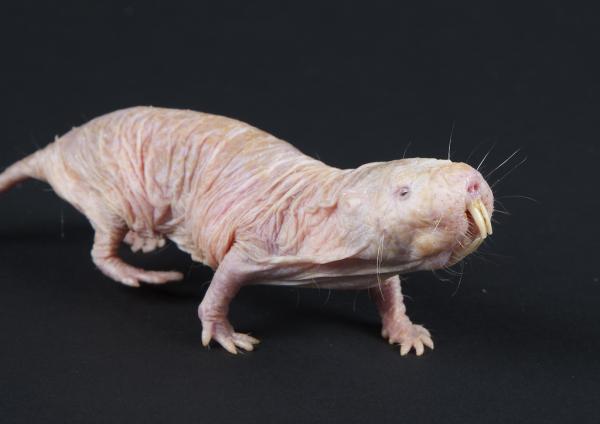In spite of having a face (and body) that only a mother could love, the naked mole rat, Heterocephalus glaber, (NMR) may provide valuable insights into the processes involved in both aging and cancer since they seem to have a low propensity for either one. Unusual among mammals, these creatures that live underground in desert areas of eastern Africa, have a social structure similar to that of hive-dwelling bees. Only one female, the queen, is capable of reproduction. The rest seem to function like worker bees, taking care of offspring and housekeeping chores.
Cancer
NMR are resistant to tumor formation, possibly because of over-expression of the tumor suppressor P16INK4A . Exploration of this resistance has demonstrated that, at least in cell culture conditions, fibroblasts from NMR produce an unusually viscous version of hyaluronan (HA), a disaccharide glucuronic acid, which is a major constituent of the extracellular matrix in vivo. Dr. Xiao Tian from the University of Rochester and colleagues determined that this particular HA was about five times larger than the HA produced by either mice or humans — and thus they called it high molecular mass HA. These researchers demonstrated that not only did the NMR cells produce this more viscous HA, it was abundant because enzymes that degraded it were not normally active, and also because of the presence of a unique HA-producing enzyme. Importantly, removal of the high molecular mass HA from fibroblast cultures causes NMR cells to become susceptible to malignant transformation.
Aging
Laboratory mice and rats have lifespans of about 2 years. Naked mole rats, however, have been documented to reach 20+ years before they begin to decline — indeed, individuals have been noted to reach 30 years of age — an incredible age for such a small rodent (they're typically 3-4 grams in weight). Dr. J. Graham Ruby from the company Calico Life Science LLC and colleagues used 35 years of data from an ongoing captive colony of NMR to assess the longevity of these animals and to compare it to that of other mammalian species.
In other mammals, the hazard of mortality (death) increased with age, as shown in the figure below. However, they found that irrespective of breeding status or gender, that of the naked mole rats did not.

Tsex in the figure above refers to the age at which the particular species becomes capable of reproduction. For the mouse, human, and horse, but not the NMR, the mortality hazard increases rapidly once reproductive maturity is reached as seen in graph E. Note that the rates differ for the different species, reflecting their different life spans. The authors stated
Most mammals live beyond that age [of reproductive capability], as is required to provide progeny with support and nurturing, but show signs of demographic aging within a few fold of Tsex; from this perspective, the naked mole-rat is exceptional, showing no signs of demographic aging many dozens-of-fold beyond Tsex .
They also noted that
body composition, bone quality, and metabolism maintenance are evident. Age-associated chronic diseases such as cancer are rare. Within the cell proteasome function, as well as mitochondrial mass, gene and protein expression are maintained with age.
So not only are the animals less likely to develop cancer, their cellular metabolic profile seems to be maintained at normal levels well beyond the expected age.
It's not yet clear how the extraordinary longevity of the NMR can be applied to the human condition. However, the underpinnings of the animals' condition should be further explored to see if some practical application can evolve.



